MOTORNET: Estating The Obvious
Estating The Obvious
SCOOP MOTORNET with Karl Ferguson
Images by Neil Mackenzie - http://www.onlinefotos.com/neil
It's a bold statement, but our fascination with oversize Sports Utility Vehicles could well be coming to an end. It had to happen sometime. After all, crossover vehicles, smaller and better built 4WDs and the rising cost of fuel are all likely to be contributing factors. Which begs the question - if not 4WDs, then what? Could the venerable station wagon be overdue for a comeback?
Two car makers who have resolutely stuck to the principle that every good sedan needs an estate, or in this case, sportwagon equivalent are Peugeot and Volvo. Both brands have recently released new sedan ranges and either simultaneously or in quick succession, introduced a complementary sedan based wagon.
The Peugeot 407 sportwagon and the Volvo V50 may not be direct competitors in terms of size, but they come pretty close on dollars, with entry level pricing for the Peugeot a whisker under $53,000 and the Volvo just shy of $58,000. And while they may not quite be in the league of the big three German manufacturers, both make for attractive European alternatives to other mainstream offerings from Australia and Japan.
Both base models come with generous equipment levels and better than average power plants. The Peugeot, a 2.2 litre four cylinder engine producing 116kW and the Volvo a 2.4 litre five cylinder producing 125kW. A six speed manual is standard on the 407 while the V50 opts instead for a five-speed automatic transmission (with sport shift) as standard.
As is generally the case, greater budget brings improved performance and additional luxury and the 407 and V50 are no exception. The 407 3.0 litre sportwagon V6 tops out at $65,490, while the V50 2.5i T5 is a not insignificant $72,990.
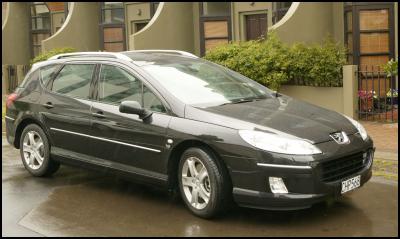
Peugeot 407 sportwagon
Click for big version
There's no doubt that visually the 407 is a significant progression from the 406, in both sedan and estate form. Where the 406 was attractive if a little conservative, the 407 is bold and daring. The design is characterised by a long nose, large headlights, and a huge grill. It works well, particularly the tapered rear of the sedan, but I remain less convinced about the sportwagon. From some angles - particularly the rear three quarter view - it looks good, but in profile, the nose looks too long for the tail and is not helped by the sharply angled d-pillar. It's not unattractive, just different from what you would normally expect from Peugeot. One of the neat advantages of the sportwagon over the sedan though is the panoramic roof which extends virtually the length of the car. Although it's fixed, it makes for an ambient interior (a powered blind will shut out the sun if it isn't your thing).
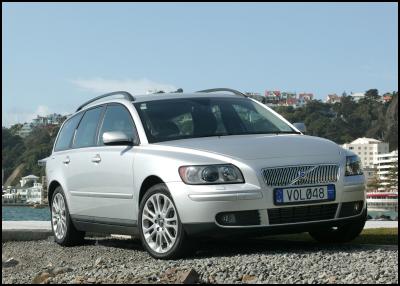
Click for big version
Similarly, the Volvo V50 is a giant leap forward on the V40 it replaces. Styling is definitely in the family, with themes derived from the larger V70, but with a forward angle on the d-pillar, it is less boxy than Volvos past. It's a good looking car in most respects but compared to its larger brethren can look vaguely 'shrunk' down to size. Nevertheless, it is a clean design with a thoroughly modern look and feel.

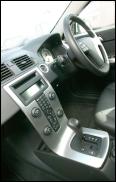
Interiors – 407 left - V50 Right
Click for big versions
Interior wise, both cars fair well. Equipment levels are high with leather, top quality stereos, and virtually every creature comfort you would expect in car of this class. Fit and finish is excellent on both cars, though the Volvo has a slight edge in this department. Similarly, while the dash layout of the Peugeot is clean and modern, the Volvo goes one better with a slimline centre console that is proud of the dash. It's quite a departure from the Volvos of old. Where the 407 comes into its own is on space. It's noticeably bigger interior allows room to move for passengers and driver alike, and the cramped feel of the Volvo was not helped by the black on black materials of the test car. Rear passengers are likely to find the legroom in the Volvo a mite constricted and the bench is a tad firm, though front seats are almost the measure of the Peugeots which are great (in the front and the rear). As load carriers, the Peugeot can carry 450 litres to Volvo's 417 litres. Two points that I couldn’t help but notice about the Volvo: the incessant nature of the seatbelt reminder and the self-locking doors. I am all for safety on cars but not at the expense of the driver's sanity, which these two features challenged on a number of occasions...
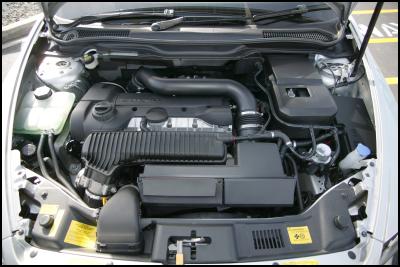
V50 Engine
Click for big version
In the power department, the top of the line Peugeot plays it straight with a naturally aspirated V6 while Volvo opts for a 'blown' in-line five cylinder. The V50 produces 162kW and can manage the 0-100 sprint in (a claimed) 7.2 seconds. The 407 produces 155kW with similar performance to the Volvo. Both are good engines, don't get me wrong, but the Peugeot's V6 is such a great example of how a well sorted engine can make a car more than just good. It leaves the Volvo’s motor seeming hardly memorable. The V6 is hugely responsive providing instant power in a linear and direct fashion, accompanied by a very satisfying and guttural engine note. In contrast, the V50 sounds a bit like a blocked vacuum cleaner and decidedly too industrial for this price bracket. Even so, performance is impressive and there is no turbo lag to speak of. It's worth keeping in mind that depending on driving habits, the blown V50 is likely to be overall more fuel efficient than the Peugeot.
With the added advantage of reduced weight over the front wheels and sportier set-up, the V50 should outshine the Peugeot in terms of handling dynamics, but it doesn't always work out in real life as it does on paper. The Volvo is certainly a very good drive and a huge improvement over its predecessor. Steering is communicative and it turns in crisply and tautly, effectively putting Volvo into a new class of handling for its vehicle line up. A Volvo that's safe and fun to drive may sound like a reach, but with the V50 it's true.
In contrast, what's so impressive about the Peugeot is not so much that it handles better than the Volvo - it really doesn't - but more that the car has an overtly luxury feel to it, including the bump-absorbing ride you would expect in such a car, and still handles incredibly well. At every turn, you expect the nose of the 407 to push wide in an ungainly and luxury fashion, but instead it tackles the corners like a vehicle half its size. It really is a good drive. Admittedly, the additional weight has slightly corrupted the handling of the 407 and some may opt for the less expensive 2.2 litre as a result. Personally, I would live with the slight handling trade off and enjoy the lusty V6.


Boot Interiors - V50 Left - 407 Right
Click for big versions
Both vehicles offer state of the art transmissions, with a sport or pseudo manual option as standard. I tend to wonder how much use the sport option is likely to get but in both the 407 and the V50 it offered a welcome alternative to the full automatic and was particularly helpful in spirited driving. The slightly newer 407 goes one better than the V50 in equipping the V6 with a six-speed transmission over the Volvo's five-speed transmission.
At this end of the market, ultimately the decision on which vehicle to purchase is more likely to come down to brand preference than price. The Volvo offers a classy touch of Scandinavian functionality with a truly enviable record on safety, while the Peugeot has true Gallic flair with a price advantage to boot. Wagons may not be to everyone's taste, but these two offer all the driving attributes, style and performance of their sedan siblings with the combined advantage and versatility that the extra space of a 'sportwagon' can offer. Collectively, Peugeot and Volvo’s combined efforts are unlikely to be enough to sway the die-hard ‘giant’ SUV loving set, but a few more trips to the fuel pump could certainly get them thinking…
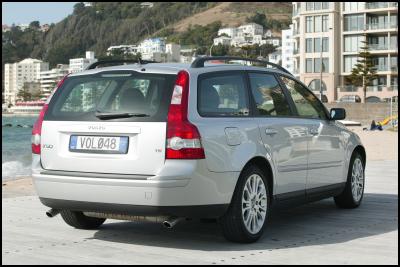
Click for big version
ENDS


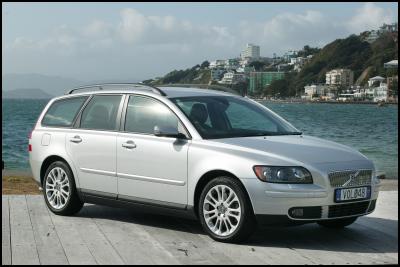
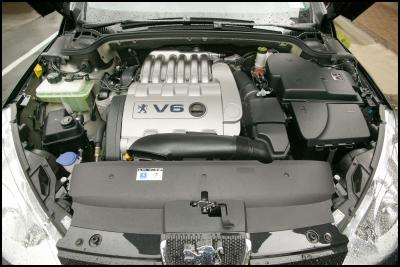
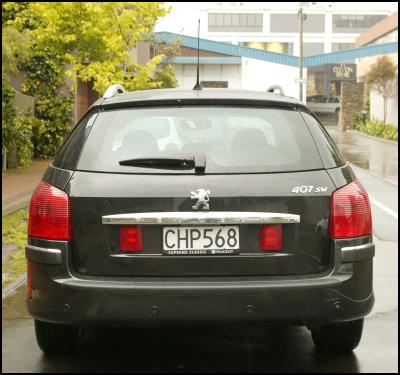
 Keith Rankin: Who, Neither Politician Nor Monarch, Executed 100,000 Civilians In A Single Night?
Keith Rankin: Who, Neither Politician Nor Monarch, Executed 100,000 Civilians In A Single Night? Eugene Doyle: Writing In The Time Of Genocide
Eugene Doyle: Writing In The Time Of Genocide Gordon Campbell: On Wealth Taxes And Capital Flight
Gordon Campbell: On Wealth Taxes And Capital Flight Ian Powell: Why New Zealand Should Recognise Palestine
Ian Powell: Why New Zealand Should Recognise Palestine Binoy Kampmark: Squabbling Siblings - India, Pakistan And Operation Sindoor
Binoy Kampmark: Squabbling Siblings - India, Pakistan And Operation Sindoor Gordon Campbell: On Budget 2025
Gordon Campbell: On Budget 2025